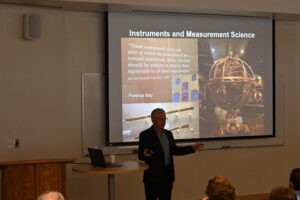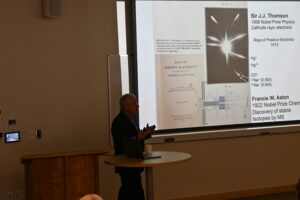Monday, Mar. 31 & Tuesday, Apr. 1 with Evan Williams
Professor J. Calvin Giddings was a graduate of Brigham Young University, earned his Ph.D. under Henry Eyring at the University of Utah in 1954, and did postdoctoral work at the University of Wisconsin. He joined the faculty of the University of Utah in 1957. Among analytical chemists, Professor Giddings was best known as a pioneer in chromatography and separations, particularly in theory and teaching. Giddings established the journal Separation Science and Technology and was editor for over 30 years. He authored over 400 scientific publications, including the theoretical landmark books Dynamics of Chromatography, and Unified Separation Science, widely used in graduate-level separation courses. He also invented Field Flow Fractionation and led the way in its development and application.

Evan Williams
Evan Williams is a distinguished faculty member in the Department of Chemistry at the University of California, Berkeley. With a career spanning over three decades, his expertise lies at the intersection of mass spectrometry, biochemistry, and chemical analysis. Professor Williams completed his B.S. at the University of Virginia in 1984 and earned his Ph.D. from Cornell University in 1990. Following his doctoral work, he was awarded a National Science Foundation Postdoctoral Fellowship, which allowed him to further advance his research in the field.
Professor Williams’ groundbreaking work in the development of mass spectrometry techniques has earned him numerous accolades throughout his career, including the prestigious National Science Foundation Young Investigator Award, the Arnold and Mabel Beckman Foundation Young Investigator Award, and the American Society for Mass Spectrometry’s John B. Fenn Distinguished Contributions Award. He has also held significant leadership roles, such as Associate Director of the Center for Analytical Biotechnology at UC Berkeley and Faculty Director of the QB3/Chemistry Mass Spectrometry Center. His contributions have been recognized by various scientific communities, including his election as a Fellow of the American Association for the Advancement of Science in 2012.
In his research, Professor Williams focuses on pioneering new instrumental and computational techniques in mass spectrometry, laser spectroscopy, and separations. His lab is dedicated to understanding the structure and function of biomolecules, noncovalent macromolecular complexes, and the fundamental chemical processes that underpin molecular interactions. Current projects include the development of advanced charge detection mass spectrometers, novel ionization methods, and high-throughput assays to study protein aggregation related to neurodegenerative diseases. His work also explores ion solvation, the effects of confinement on chemical reactivity, and the development of spatially resolved mass spectrometry for detailed analysis of cells and tissues.
Overcoming Molecular Complexity One Ion at a Time
Abstract: Heterogeneous materials can be challenging to analyze especially when the masses of individual components extend beyond 100 kDa. With mass spectrometry, individual charge states produced by electrospray ionization can be difficult to resolve due to overlaps in m/z from other components or from adduction of salts or other non-specific molecular interactions. One demonstrated solution to this problem of sample heterogeneity for high mass analytes is to measure the charge as well of the m/z of individual ions so that the mass of each ion can be determined without interference from other ions. Single ion mass measurements have been performed with a variety of instrument types, but charge detection mass spectrometry with electrostatic ion traps have the advantage of virtually unlimited mass range, single charge accuracy, and the ability to make dynamic measurements. A primary challenge is to acquire single ion data sufficiently rapidly to make this method practical. Solutions to this challenge, as well as state of the art capabilities of charge detection mass spectrometry and applications to viral and nanoparticle analysis will be discussed. Results from experiments aimed at understanding the chemistry and physics of charged droplets, structures and reactivities of viruses, and applications in nanoparticle characterization will also be presented.
A Window into Molecular Complexity with Mass Spectrometry: From Physics to Chemistry to Biology and Beyond
Abstract: Since its inception in the early 1900 by the physicist Sir J. J. Thomson, mass spectrometry has played an important role in advancing scientific discoveries in many different disciplines. Early studies in physics provided evidence for nonradioactive isotopes. Advances in mass spectrometry instrumentation made it possible to obtain detailed information about molecular structure making it an indispensable tool for chemists that is now widely used in drug detection, natural products, and environmental analysis of trace contaminants. New ionization methods expanded the types of structures that can be analyzed by mass spectrometry, extending powerful molecular analysis tools to biology and related fields. Various applications of mass spectrometry in these fields, both historical and state-of-the-art will be presented, along with some speculations of what might lie ahead.

History of Giddings Lecture Speakers at the University of Utah
2023-2024
Marc Koper, Leiden University
How to understand rates of electrocatalytic reactions & How to make green hydrogen
2022-2023
Informing Ocean and Atmospheric Aerosol Chemistry: Interfacial Organization and Inherent Electric Fields at Aqueous Surfaces
2020-2021
Structural Characterization of Lipids, Nucleic Acids, Proteins, and Molecular Machines using Ion/Ion Chemistry
2019-2020
Jeanne Pemberton, University of Arizona
Fun with Sugars: Some Mundane and Not-So-Mundane New Materials from Glycolipids
2017-2018
Nanostructured Mesoscale Optical Materials
Operando Methods for The Study of Energy Materials & The Energy Landscape in the Age of Sustainability
2014-2015
Surfaces: The work of the devil?
2013-2014
Chromatography: the transport processes that make it work & Submicrometer silica particles in protein electrophoresis
2011-2012
Chemical Cytometry – the Analysis of the Content of Single Cells & The Role of Analytical Chemistry in Sequencing the Human Genome
2010-2011
Electrochemical Surface-Enhanced Raman Spectroscopy: Past, Present and Future & Nanostructure-Enhanced Raman Spectroscopy: Towards a Versatile Analytical Strategy
2007-2008
Nanoplasmonics: From Physics to DNA Diagnostics
2005-2006
Making it Count: Quantitation of Low-Copy-Number Proteins n Single Cells
2000-2001
The inaugural speaker of the lecture
Analytical Glycobiology: a Methodological Frontier & Exploring the Limits of Separating Power: A Scientific Legacy of J. Calvin Giddings
